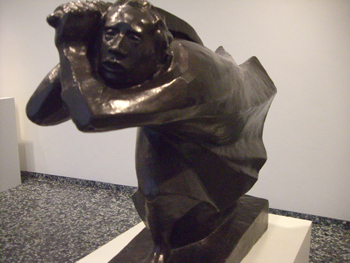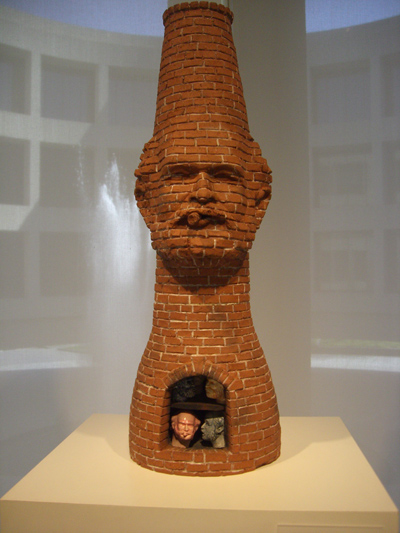
Unusual Hirschhorn offers art on Mall
WASHINGTON, D.C. — Conservative, traditional, contemporary and Victorian — which doesn’t belong?
Just like finding the misplaced word from a list is how Smithsonian Artist Research Fellow Terence Gower views the Hirshhorn Museum and Sculpture Garden against the background of the entire National Mall.
 |
The front of the Hirshhorn Museum and Sculpture Garden features a larger-than-life sculpture (Photo by Bari Lieberman). |
“The first thing that struck me about the architecture is the kind of the impossibility of this structure, this design, in this location,” Gower stated. “The Mall is quite traditional and restricted (in its) architecture and you can’t help to notice this massive concrete doughnut. It is quite a radical statement.”
By looking at a building’s architecture and how it is represented, Gower believes that The Hirshhorn Museum and Sculpture Garden offers a nonconformist perspective to the traditional concept of the relationship between a structure and what it holds, as well as offering a unique and controversial history.
“(The museum is) quite brutal as a context for other sculptures and it’s very hard to show sculpture in the immediate vicinity of the museum,” Gower stated.
The Hirshhorn is the Smithsonian’s museum of international and contemporary art, and the building itself serves as a contemporary piece. Designed by Gordon Bunshaft, Gower described his project as “a large piece of functional sculpture.”
The Hirshhorn is located on the National Mall between the National Air and Space Museum and the Smithsonian Castle on Independence Avenue. And, just as the museum’s structure stands out on the National Mall, the Hirshhorn’s founder, Joseph Hirshhorn, does not quite fit the stereotype of the typical art collection donator.
Rather than being raised amongst the culturally sophisticated, Joseph represents the quintessential American dream. After immigrating to the United States from Latvia at six years old with his 12 siblings, Hirschhorn was raised in the slums of Brooklyn.
| A ceramic sculpture on exhibit at the Hirshhorn Museum (Photo by Bari Lieberman). |  |
Making his money through the stock market as a teenager, he withdrew his investments not long before the stock market crash and moved to Canada in the 1930s where he made about $150 million through mining, particularly that of uranium.
Hirschhorn had a passion for collecting art and always dreamed of donating his collection to the public. His original location for his museum was in Ontario, Canada, but when plans fell through, he received bids from London, Tel-Aviv and Los Angeles and finally accepted a bid from Washington, D.C., to construct a home for his collection and give back to the country that gave him his initial success.
“(Bringing the collection to Washington) started with a real gentlemen’s agreement between Hirshhorn and (President Lyndon) Johnson. There was actually a letter Johnson writes that says ‘we’d love to have your collection’ and it was very obsequious and Hirshhorn was seduced and he suddenly got very patriotic and decided to bring the collection to Washington,” Gower stated.
In 1966, a Congressional act established the Hirshhorn Museum making it federally funded museum; however, resources for the development ran short and Hirshhorn donated $1 million to complete the construction.
According to Gower, unlike other donors, Hirschhorn was incredibly generous and open minded. He did not impose a lot of restrictions and allowed the Smithsonian to change the collections as deemed necessary, especially since he was considered to have “eccentric” collecting habits.
The museum was built using the period’s new technology of tension concrete, which allows the circular structure to stand on four massive piers and extend outwards without supporting beams. The building is 82 feet high and 231 feet in diameter with a 60 feet fountain located in the middle of the circle.
 |
Sculptures on display in a circular gallery at the Hirschhorn Museum (Photo by Bari Lieberman). |
The museum has four floors with exhibits on the lower three and the curved galleries have inside window-walls that allow visitors a view of the outside fountain. The sculpture garden is located across Jefferson Drive and is sunken six to 14 feet below street level.
“(The museum) was a brutalist statement. The most radical thing about it is that it hovers, it’s this giant, unbelievably heavy cylinder that hovering on four feet,” Gower stated. “Bunshaft at this point of his career was taking this modernist idea of figuring out what you need to do in the building and then you design the building around that function. He was exploring this new area of form fellow’s technology.”
According to Gower, five years after Congress’s act to build the museum, there was a controversy in which Congress tried to cease the museum’s construction halfway though. The major issues pertained to Bunshaft’s original concept of extending the sculpture garden across the entire National Mall. Construction continued, but the garden was limited to only 1.3 acres.
“Politics always are leaving their imprint on the city itself architecturally,” Ryan Hill, curatorial research associate, stated.
The Hirshhorn Museum’s construction resulted in numerous debates amongst Congress and controversy arose again in 1971 when an obscure Congressional Committee objected to the museum project.
| The “Play Dead, Real Time” elephants exhibit by photographer Douglas Gordon (Photo by Bari Lieberman). |  |
According to Gower, the objections were over a mixture of aesthetics and unease about Joseph Hirshhorn and having his name represented on the National Mall next to such icons as Abraham Lincoln.
“There were rumors of anti-Semitism over those kinds of objections and what’s ironic is that the fear of being labeled as anti- Semitic was part of the reason this project was pushed through,” Gower stated.
After numerous tensions, the museum finally opened in 1974. Today, the museum possesses collections from artists such as Picasso and Warhol and houses over 11,500 pieces (both permanent and temporary) ranging from paintings, sculptures and mixed-media installations.
Since the Hirshhorn is a contemporary art museum, artwork ranges from the traditional sculptures and paintings to the more unique pieces of a slanted phone booth or a video installation of an elephant playing dead, “Play dead, real time” by Douglas Gordon. There are no doors between exhibits so visitors can move freely between rooms and the circular design of the museum allows guests to become easily immersed in the immensity of the collections.
Upon entering the museum from Jefferson Drive, guests are greeted with the museum’s largest piece of artwork, Roy Lichtenstein’s Brushstrokes, which was added in 1996. Hirshhorn’s collection represents both modern and contemporary artwork and highlights renowned and influential artists from around the world such as Willem de Kooning, Henri Matisse, Gerhard Richter and Ed Ruscha.
Current exhibitions include “Directions” by Virgil Marti and Pae White, which is displayed in the museum’s lobby and “Refract Reflect Project: Light Works from the Collection” which highlights works of the collection involving light and how it interacts with and occupies space.
There are also John Baldessari’s “Ways of Seeing” which brings together rare pieces of the Hirshhorn collection and “Black Box” by Magnus Wallin which is an animation of the mechanics of human anatomy located on the bottom floor.
 |
Sculpture on display at the Hirschhorn Museum (Photo by Bari Lieberman). |
The Hirshhorn also offers programs such as Meet the Artist, Gallery Talks, Gallery Tales for Tots, film showings, After Hours and ArtLab, a five-week program for artistically talented teenagers from local high schools.
Irony seems to run through all aspects of the museum from the founder’s background to the source of its funds- part of the money used to build such a culturally enriching museum was derived from uranium mining which went on to produce nuclear weapons.
Built prior to most current museums on the National Mall, the Hirshhorn fully embraced the progressivism of its time and offers a fresh and seemingly rebellious perspective to the classical, conservative nature of the National Mall.
If You Go
- The Hirshhorn Museum and Sculpture Garden is located on the National Mall at 7th Street SW and Independence Avenue.
- Hours of operation are from 10 a.m. to 5:30 p.m. and admission is free.
- Daily tours of collections and exhibitions are offered as well as Friday Gallery talks with special guests. There is no flash photography.
- Facilities include a museum store, restrooms and wheelchair accessibility.
- For more information and updated event calendars, please contact the museum at 202-633-1000 or at http://www.hirshhorn.si.edu.

Comments are Closed